Numerous books about the guerrillas in the Philippines during World War II mention that they were eventually--starting in 1943--supplied with arms, medicine and food by American submarines dispatched from Australia. However, only this book concentrates exclusively on the submarines that served as resupply ships--either part or full time--and the men who sailed them.
Considering the lack of almost everything the guerrillas needed, the supplies eventually brought in by submarines let tens of thousands of Filipinos and a handful of Americans who stayed behind exact a terrible price from the Japanese for the atrocities committed by the Imperial Army.
The primary historical character in this book is LtCmdr Charles "Chick" Parsons, of U.S. Navy Intelligence, whose adventures in the Philippines during the Japanese invasion and whose escape from the Philippines is worthy of a movie. His later exploits in his numerous trips backs to the Philippines are just as exciting but are not discussed here in the detail they deserve. After all, this is a book about the submarines.
It is well that the book mentions Parsons often, as contacting, evaluating and supplying the guerrillas and their American and Filipino leaders was his primary duty. However, for reasons too detailed to go into here, there exists both a pro-Parsons camp and a pro-Fertig camp. Col Wendell Fertig (see Wikipedia) organized and lead tens of thousands of Filipino guerrillas, with some Americans, on Mindanao. The authors of this book are obviously in the pro-Parsons camp and spend some time early on making disparaging remarks about Col Fertig that cheapen their story. Plus, they assign to General MacArthur and some of his subordinates more credit for establishing the Philippine guerrilla movement than these men deserve.
I suspect, especially after exchanging some e-mail with Parsons' youngest son, that two very forceful leaders, both of whom had years of experience in the Philippines, had two very different ideas about the mission of the Filipino guerrillas and, as a result, clashed.
If you are interested in studying one of history's greatest guerrilla movements, this book provides excellent details on the role of the U.S. Navy submarine service in supporting that movement. As I have read numerous books on the men who fought behind Japanese lines in the Philippines, I was delighted to find this book.
Considering the lack of almost everything the guerrillas needed, the supplies eventually brought in by submarines let tens of thousands of Filipinos and a handful of Americans who stayed behind exact a terrible price from the Japanese for the atrocities committed by the Imperial Army.
The primary historical character in this book is LtCmdr Charles "Chick" Parsons, of U.S. Navy Intelligence, whose adventures in the Philippines during the Japanese invasion and whose escape from the Philippines is worthy of a movie. His later exploits in his numerous trips backs to the Philippines are just as exciting but are not discussed here in the detail they deserve. After all, this is a book about the submarines.
It is well that the book mentions Parsons often, as contacting, evaluating and supplying the guerrillas and their American and Filipino leaders was his primary duty. However, for reasons too detailed to go into here, there exists both a pro-Parsons camp and a pro-Fertig camp. Col Wendell Fertig (see Wikipedia) organized and lead tens of thousands of Filipino guerrillas, with some Americans, on Mindanao. The authors of this book are obviously in the pro-Parsons camp and spend some time early on making disparaging remarks about Col Fertig that cheapen their story. Plus, they assign to General MacArthur and some of his subordinates more credit for establishing the Philippine guerrilla movement than these men deserve.
I suspect, especially after exchanging some e-mail with Parsons' youngest son, that two very forceful leaders, both of whom had years of experience in the Philippines, had two very different ideas about the mission of the Filipino guerrillas and, as a result, clashed.
If you are interested in studying one of history's greatest guerrilla movements, this book provides excellent details on the role of the U.S. Navy submarine service in supporting that movement. As I have read numerous books on the men who fought behind Japanese lines in the Philippines, I was delighted to find this book.




